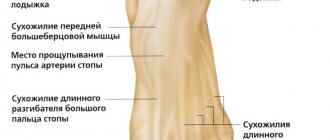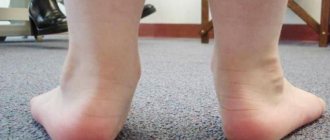For what reasons can your toes hurt?
The most common causes of pain:
- injuries;
- frostbite;
- reaction to insect bites;
- excessive load on the legs;
- infectious lesions of nails and skin, including fungal ones;
- joint diseases;
- swelling caused by chronic diseases.
In women, discomfort and numbness are often associated with wearing poorly chosen shoes. Over time, the foot becomes deformed due to compression, misalignment, or overuse. Thus, pain can be either a consequence of leg fatigue, or a sign of an already developed pathology of the articular joints. With moderate discomfort, if there is no redness of the skin, swelling or fever, help is limited to rest and applying ice. If the pain is severe, you should consult a doctor.
Causes of finger arthritis
The disease is an inflammatory process affecting the metacarpophalangeal, metatarsophalangeal and interphalangeal joints of the upper and lower extremities. Most often, it is not an independent disease, but develops against the background of other pathologies (rheumatic, infectious, metabolic). Our center's kinestherapists provide effective treatment for finger arthritis.
The following causes of the disease are identified:
- age (the disease develops more often in older people);
- disruption of the endocrine glands;
- minor bone damage;
- infections (flu, ARVI);
- heredity;
- injuries, bruises, previous operations;
- bad habits (nicotine, alcohol);
- disorders in the vascular system (deterioration of joint nutrition);
- stress (stress hormones worsen the composition of joint lubrication).
Pain after injury
If discomfort appears after wearing open shoes, you need to check your feet for bites, minor scratches and other injuries, changes in the shape or color of the nails. Often, infections cause inflammation and swelling. Most often, the tips of the toes hurt. If the pain is mild, you can first consult a therapist. If the finger is very swollen, red or blue, or occupies an unnatural position, this may indicate a serious injury: a fracture, dislocation, or severe bruise. In this case, you need to contact a traumatologist.
Pain due to joint pathologies
In case of swelling, constant severe pain, or deformation of the limbs, consultation with an orthopedic traumatologist or rheumatologist is necessary. The presence of articular pathologies is signaled by such signs as:
- frequency of unpleasant sensations;
- frequent swelling;
- deformation of articular joints;
- increase in temperature in the affected area.
Often, sharp pain in the toes indicates a dangerous disease - gout. This condition is caused by excess amounts of uric acid compounds in the body. Over time, its crystals (urates) accumulate in internal organs and joints. In most cases, the lower extremities are primarily affected. Deformation occurs first in the toes and then in the knees. Gout is characterized by periodic attacks with a sudden onset, when the patient wakes up in the middle of the night from acute pain, which is accompanied by severe redness of the skin, swelling, fever and signs of intoxication. Often, fingers hurt due to another common disease - arthritis. With this pathology, inflammation of the joint occurs and cartilage tissue is destroyed. The disease often develops after a primary illness, for example, tonsillitis. The infection can enter the joint through a small wound. Non-infectious arthritis can be triggered by repeated injuries, autoimmune disorders, and unbalanced nutrition. Sometimes the cause of pain is arthrosis. This degenerative disease also affects cartilage tissue and destroys joints, causing severe deformation and the formation of osteophytes - bone growths that significantly limit mobility. Over time, the patient develops severe lameness; walking requires a cane or other support, since the affected foot cannot cope with the load.
Chronic forefoot pain
Hello. My name is Alekseev Mikhail Ivanovich, I am an orthopedic traumatologist, and in the clinic I treat foot surgery problems. Today I would like to talk to you about chronic forefoot pain, or metatarsalgia as it is called. What it is? Pain in the forefoot is very common for patients. What could it be connected with? Pain in the forefoot can occur in different situations. This is a manifestation of transverse flatfoot. What it is? To make it clear to you, I will turn to a dummy. This is our foot. The dummy is made of a foot that is no longer completely healthy; it is a diseased, deformed foot. But to make it clear to everyone, our feet have 3 arches. This is a longitudinal arch; if we look at everything from the side, this is longitudinal flatfoot. This is the lateral arch of the foot that we have here. And what I was talking about – transverse flatfoot – is a longitudinal arch. That is, if we look at the foot from here, we will have an arch like this. That is, this is a transverse arch that allows us to move smoothly, and the entire load falls on the 1st and 5th metatarsal bones. And 2,3 and 4 do not load the supports during the process.
Foot Surgery Center Read more
With pathology, the situation changes, the foot takes on a different shape. This is a reverse arch, and instead of an arch directed towards the rear, we have an arch directed in this direction. And therefore we are forced to walk on the small metatarsal bones. This causes chronic overload and chronic pain. Chronic pain in the forefoot can occur as a result of the development of nerve pathology, the so-called developing neuroma. On the foot, Mortan's neuroma - you may have heard, they talk and write about it a lot now - it is also associated with chronic overload. As a result of chronic overload in the intermetatarsal spaces, this is between the second and third toes, that is, in the metatarsal region, due to chronic overload, a restructuring of the plantar nerve, the common digital nerve, occurs. It thickens, causing scar tissue to compress it and causing constant pain. The pain intensifies when walking in tight shoes, the pain intensifies when driving a car. With Morton's neuroma, the pain has a completely characteristic direction. Patients are primarily concerned about a burning pain that shoots into the fingers.
The pain is so intense that they are forced to take off their shoes and stand, stretching their feet, without shoes. Or when you get home, use ice or a cold bath to relieve the pain. Pain in the forefoot can also occur with pathology of the lumbosacral spine. Therefore, it often becomes difficult to diagnose yourself. Even when visiting a general practitioner, it can be very difficult to make the correct diagnosis and, accordingly, choose the right treatment method. Therefore, if you experience pain in the forefoot, of course, it is better to consult a specialist in foot surgery.
As a result of the examination, what can we identify and what do we apply? Firstly, during the examination we determine: there is transverse flatfoot, there is no transverse flatfoot, there are zones of pathological overload, there are no zones of pathological overload, and accordingly, we can refer you to additional examination methods. This is, first of all, radiography in standard settings and this is an ultrasound examination of the soft tissues of the foot, which allows us to identify any pathological formations, neuromas, tendon ganglion and, accordingly, choose the right method of treatment.
There are never too many promotions
More details
What treatment methods do we use in different situations? I will briefly talk about the correction of transverse flat feet. We primarily use surgical interventions aimed at removing these metatarsal bones from the overload zone. This is subjected to osteotomy in special versions, the bones rise upward, it all grows together very quickly and chronic pain goes away. Morton's neuroma, which I mentioned above, can be treated both conservatively and surgically. Our clinic has already developed indications for surgical intervention based on the results of ultrasound examination. If it reaches a certain size, we simply remove it. The operation takes us no more than 10 minutes. The access is minimal to 2 cm, the neuroma is removed under intravenous anesthesia, and after 2-3 hours the patient can safely go home on his own feet. After 2 weeks, as a rule, we remove the stitches, and the recovery period ends. If the neuroma has not reached the specified size that ultrasound gives us, we use conservative treatment methods, including the selection of individual insoles, we refer them to specialists who deal with this, and we can perform therapeutic blockades. That is, 1-2 blockades can remove all your problems that have been bothering you for many, many months. Therefore, we use surgical intervention only for strict indications.
Very often we can get by simply using methods such as selecting individual shoes, individual insoles, which leads to a reduction in pain or to its complete recovery. If you do not contact a specialist in time, then you and I can get a serious complication of transverse flatfoot such as damage to the plantar plate and the development of visible deformities. Toe deformities. Many have seen or heard of patients with such curvatures, the so-called hammer toe, foot deformity. This is a consequence of transverse flatfoot, which was not diagnosed in time and, accordingly, not treated in time. Therefore, I would like to remind you once again that for any pain in the forefoot that occurs against the background of complete health, or occurs after overload, it is better to consult a specialist. You will spend 30-40 minutes of your time, but you will have the opportunity to choose the right treatment on time.
Installment plan for all clinic services
Read more
What to do if your toe hurts?
If severe pain occurs, you must:
- remove shoes and socks;
- provide limbs with rest, preferably in an elevated position;
- Avoid drinking alcohol, fatty and smoked foods.
If the pain is very severe, you can take a painkiller. If the temperature rises and swelling, an anti-inflammatory drug is required. If pain appears after a bruise, ice should be applied to the affected area. You should not warm your feet in a hot water bath before consulting a doctor. When moving, you should use a support to reduce the load on the limb. After your condition improves, try to get medical advice as soon as possible. If there is severe pain in the fingers, a number of diagnostic procedures may be required:
- laboratory tests (blood and urine, joint puncture, allergy tests);
- study of skin microflora;
- X-ray;
- MRI;
- CT;
- and other studies.
A thorough examination will reveal the presence of inflammatory diseases, changes in the shape and structure of joints and other abnormalities. The diagnostic results will allow the doctor to find out exactly the reason why your toes hurt and to correctly decide how to treat this disease.
Features of treatment
After the doctor determines why the patient's toes hurt, he will develop a treatment plan. In advanced cases, surgery may be required, but treatment is usually limited to conservative methods:
- drug therapy;
- physiotherapy;
- physical therapy.
Painkillers are necessary if your toe hurts very badly. Anti-inflammatory drugs and decongestants are also recommended. Sometimes taking chondroprotectors is required.
Physiotherapy improves blood circulation and metabolism, eliminates pain and swelling, and accelerates tissue recovery. Therapeutic exercise ensures the development of muscles and ligaments, which is necessary for proper distribution of the load on the legs, preventing repeated injuries and exacerbation of joint diseases. On the website you can find prices for services. To prevent pain, a healthy diet, wearing comfortable shoes, and avoiding excessive stress and hypothermia are necessary. It is also advisable to continue doing therapeutic exercises - this will help maintain muscle tone and healthy joint mobility.
We specialize in the treatment of the musculoskeletal system, even in severe stages of disease. For 10 years we have been helping thousands of patients avoid surgery.
Our doctors
This is the strongest team of experts who teach at the RUDN Department. We are the clinical base of leading universities, where the best doctors in Moscow, unique specialists from Russia and abroad are trained.
Treatment of pain in the joints of the legs
If you have pain in your leg joints, do not self-medicate under any circumstances. Due to improper treatment, complications can arise, which are much more difficult to cure than the primary disease. Make an appointment with a neurologist or orthopedic traumatologist. The doctor will listen to complaints, perform palpation, and prescribe additional examinations: ultrasound, MRI, arthroscopy and laboratory tests.
Once the diagnosis is made, the doctor will create a treatment plan. Treatment of joints includes taking various medications: anti-inflammatory, antibiotics, chondroprotectors or hormonal. Almost all patients are prescribed physical therapy and physiotherapy. In advanced cases, prosthetic surgery is performed.











